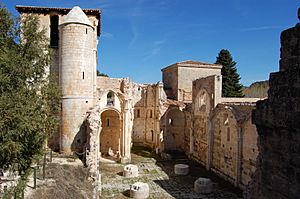Monastery of San Pedro de Arlanza facts for kids

San Pedro de Arlanza is a very old, ruined monastery in central Spain. A monastery is a place where monks (religious men) live and work together. This one belonged to the Benedictine order.
You can find it in the beautiful valley of the river Arlanza, near a town called Hortigüela in the Burgos province. It was started in the year 912. Because of its long history, people often call it the "cradle of Castile" (cuna de Castilla), meaning it was very important in the early days of the region of Castile.
The monastery was left empty in 1841. This happened because the Spanish government, led by Juan Álvarez Mendizábal, took over many church properties. These properties were then given to other people or sold.
How San Pedro de Arlanza Began
The monastery has two old documents that supposedly show how it was founded. These documents were copied in the 1100s. One document says it was founded by a powerful leader named Count Fernán González and his wife, Sancha of Navarre. The other document mentions Fernán's mother and brother, along with another count, Gonzalo Téllez, and his wife.
However, these documents have some strange parts that make historians wonder if they are real. The one about Fernán González might have been made up later. This would have been done to make the monastery seem more important and older than it really was. The document about Gonzalo Téllez is probably closer to the truth, as we know he was active around 912.
Count Fernán González and his wife Sancha were buried at San Pedro. Their tombs stayed there until 1841, when the monks had to leave. Their tombs were then moved to another church in Covarrubias.
What the Monastery Looked Like
The church you see in ruins today was started in 1080. It was built in the Romanesque style, which is known for its round arches and strong, simple shapes. It had three main sections (called naves) and three rounded ends (called apses).
Later, parts of the church were changed to the Gothic style, which has pointed arches and taller, more detailed designs. But some of the original stone carvings from the 1000s are still there.
Today, you can still see the three rounded ends of the church. The tower, built around the late 1100s, also stands. Parts of the cloisters (covered walkways where monks walked) and the chapter house (a meeting room) are also visible. You can also see a special double-arched window and the carved stone above the main entrance.
Art and History Moved Away
Over time, many important parts of the monastery were moved to other places to keep them safe or display them.
- The main entrance of the church was moved to the National Archaeological Museum of Spain in Madrid in 1895.
- A large Romanesque tomb, believed to belong to a legendary hero named Mudarra González, was moved to the Cathedral of Burgos.
- Some beautiful wall paintings (called frescoes) were taken to the Metropolitan Museum of Art in New York.
- Other frescoes, like the Paintings from Arlanza, are now in the Museu Nacional d'Art de Catalunya in Barcelona.
 In Spanish: Monasterio de San Pedro de Arlanza para niños
In Spanish: Monasterio de San Pedro de Arlanza para niños


